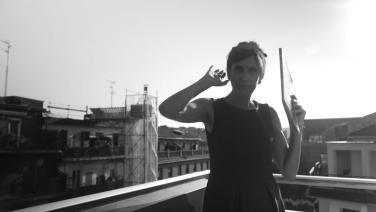12-part series that explores the changing production model by which the old tobacco factory became the current International Centre for Contemporary Culture. Lurking two big questions: what do we need from the past when it comes to work? and how and from where one can speak of memory ?
Tabakalera embodies these and many other issues, which has allocated a small space in the building, the Storage, where this series is shown as a video installation, adding a chapter each mid-month, until September 2016. The project is accompanied by a public side events.
Second part: Group impression, loneliness impression
He does not finish leaving me. But I have taken some precautions. I have given his pictures, pictures where "he" appears, to a centre that preserves the old ways, a retirement home of abandoned habits and customs fallen into disgrace. It is not that I want to forget him completely. I need some distance, no more. It is enough with this indifference brought by a nice glass cabinet. Inside of it, there are, one after another, displayed in rows, in groups of four or bigger groups, as you wish, his pictures, his images, sharing out the horrible and the beautiful in between categories that have become obsolete.
A person that organises catalogues of lost analogies tells me that the centre opens Tuesday to Sunday and that people, when put in front of old customs, exposed on those glass cabinets as if they were sardines being grilled, react with a sadistic nostalgia.
Sadistic nostalgia. What is that?
A German expert on "mixed feelings" casts light on this question. Sadistic nostalgia occurs when there is an impossibility to conceive the past unless imagined as a group of elements piled up one on top of the other, as they are usually put in the duck shooters at state fairs. Die sadistische Nostalgie vergegenwärtigt die Vergangenheit durch das Visier des Scharfschützengewehrs. ("The sadistic nostalgia remembers the past as if looking through the sight of a firearm").
Godard, via Jean Pierre Léaud in La Chinoise, said that Lumière was, arguably, "the last impressionist painter". As many times before, Godard fishes the open seas bottom-trawling. The workers that exit the factory on that famous image that initiated film history do not become actors, as Didi-Huberman stated; on the contrary, they become brush-strokes of impression. They are prisoners of a group impression, which is inversely proportional to the impression of loneliness felt by the one who is looking at them. Rear Window. Sadistic impression.
Anyway, nothing in life is never exactly like that. Not even this. In the end, we are talking about impressions, that is, a fact, an effect and affection, all joint in a single blow. An experience of encounter that always marches to the rhythm of a certainly illusory baton. So, the ways that go together with every impression and through which we feel lonely in relation to a group we see as compact (or we feel a group in relation to another we see as lonely), bring a caution operation, not really towards that other we want to constitute (or introduce) at some grade of proximity, but towards our very position in the always complex web of living. Believe it to see it. Wish it to live it.

